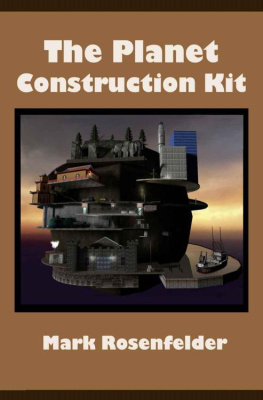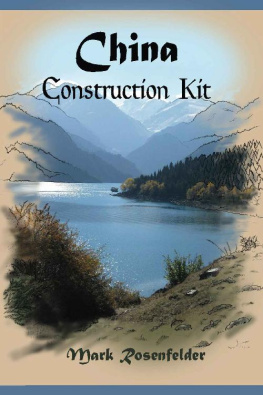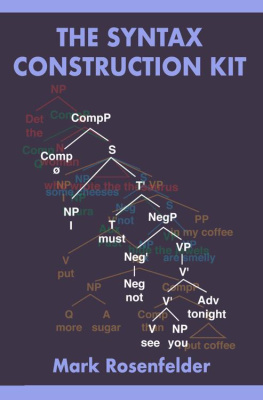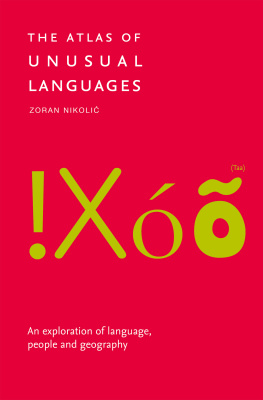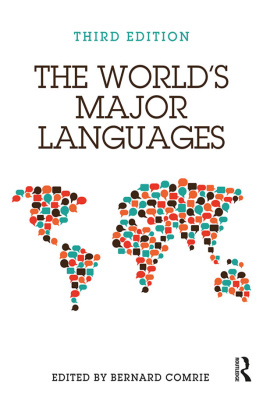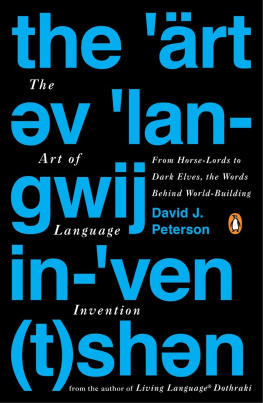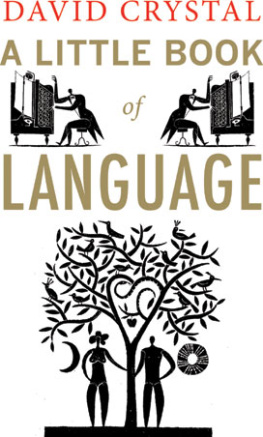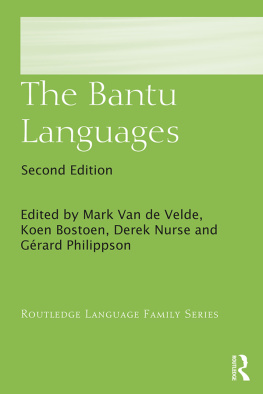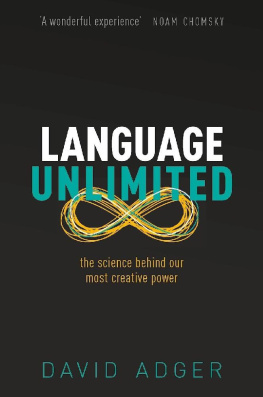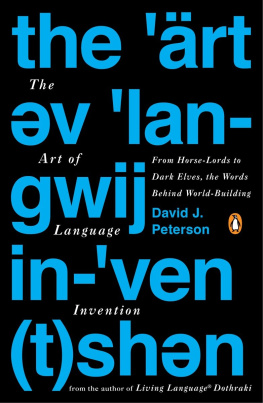
by Mark Rosenfelder

www.yonagu.com Chicago 2010
2010 by Mark Rosenfelder.
All rights reserved, including the right to reproduce this book or portions thereof in any form whatsoever, except for review purposes.
Kindle edition 2011
Contents
Introduction 4
A naming language 11
The overall process 16
Sounds 29
Word building 58
Grammar 67
Semantics 109
Pragmatics 143
Language families 182
Writing systems 216
Kebreni 237
Word lists 295
More to read 306
Introduction
This book is intended for anyone who wants to create artificial languages for a fantasy or an alien world, as a hobby, as an interlanguage. It presents linguistically sound methods for creating naturalistic languages, which can be reversed to create non-naturalistic languages. It suggests further reading for those who want to know more, and shortcuts for those who want to know less.

The above is a sample of a constructed language ( CONLANG ) of my own, Verdurian. If youre curious, it reads, iteln mu cum pn vea en er msan so Sannam , meaning Go forth in peace to love and serve the Lord. The letter / sounds like the th in then ; the vowels are similar to those of Spanish.
Before I could write this little inscription I had to:
Decide on the sounds of the language
Create the lexicon
Create the grammar
Design an alphabet
Modify the alphabet for cursive handwriting
Translate the text
Well cover all of this in the book.
The order of the steps above is significant. Working backwards (e.g. creating a text and then devising a grammar to match) will lead to an inconsistent if not incoherent work. A bad example is Hergs Syldavian; since he basically made it up in pieces, as he needed it, its impossible to create a consistent phonology or morphology for it, based on the scraps of the language provided in the Tintin books.
You can also use this book as a backhanded introduction to LINGUISTICS . To make an artificial language, after all, you have to know a lot about real languages.
For the impatient
Some books, especially the ones sold in airports, have a lot of padding... the author had an idea for an essay and wrote it as a book.
Not this one. We have a lot of material to cover, and to any expert the presentation will look pretty damn breezy.
However, Ive tried to put the most important information first, overall and within each chapter. For instance, the first chapter tells you all you need to know to make a naming language, suitable for filling out a map or making character names. You dont have to be an expert on all this stuff.
Well, unless your professor assigned it, in which case, yes, everything will be on the final.
Using this book
Overall structure
Well start with some overviews. The next chapter is on how to make a very basic language for creating names. After that, well look at the process for creating a more detailed language.
The meat of the book is a series of chapters that expand on the major parts of a grammar: sounds, word building, syntax, semantics, pragmatics.
After that are some special topics:
How to create a set of related languages
Devising writing systems
Ive included an annotated grammar of one of my conlangs, Kebreni. The grammar itself serves as a model, but Ive also discussed some of my linguistic sources, why I made the choices I did, and what Id do differently today.
Finally there are some resources: some basic wordlists, and a bibliography.
But how do I start?
This seems to be a poser for some people. I suppose its the conlanging equivalent of a writer staring in desperation at a blank page.
Well, first, read the book. You wont be using all the information at once, but its good to scout out the territory and know whats there so you can go back to it when you need it.
Create an outline for your grammar (see the naming language chapter for an example). Now you can go through the book again and pick alternatives that appeal to you. There arent any wrong choices. You want a language with ejectives, tones, SOV order, and five cases? Sure, why not?
Think of it as inventing a cartoon character. You choose a particular type of eye, a size and shape of nose, a body shape. The creativity comes in the way the character fits together it doesnt consist of creating mind-boggling new organs .
Dont read this sentence!
Oops, too late. Dont read this one, then.
Anyway, the point is, you dont have to read the book straight through. When youre reading new material, you can absorb it up to a point then your brain glazes over and its not really registering any more.
Thats fine just go back to that section later. You can also try alternating reading with creating: read a chapter, then try applying it to your conlang.
Whats it for?
Think about what the language is for.
Naming people and places. For this you need a brief outline and a wordlist.
Translating small or large texts, or simply creating the language as an artistic creation an ARTLANG . For this youll need a full grammar; its length will depend on how complete the language is. Translating a text, by the way, is a great way to find what bits of the grammar are missing.
An auxiliary language or AUXLANG . Here your choices should be determined by simplicity and accessibility.
Exploration of a logical concept e.g. youd like a language with as few words as possible; or you want to organize the lexicon scientifically, or its going to be all gestures. Obviously such experiments arent constrained by natural languages, but its still useful to know whats out there, and you should be aware of assumptions that are built into your native language.
Typographical conventions
Ive put technical terms in SMALL CAPS . This tells you two things:
I didnt make the term up, so you can safely use it in your grammar.
You can get more information by Googling. (If you get a choice between (say) Linguist List and Wikipedia, look at the former. Wikipedia isnt bad at basic linguistic terms, but it can be wrong or misleading.)
Italics are used when Im discussing a word or phrase. If its not in English Ill provide a gloss in single quotes.
Example sentences are provided with both a word-for-word gloss and a free translation. I recommend this for your grammars as well it makes it much easier to see the structure of the language.
U menya i u nyevo nyet khlyeba.
by 1s.GEN and by 3sm.GEN not bread-GEN
He and I dont have any bread.
Hyphens are used when a word can be separated into pieces: khlyeb - is bread, - a is the singular genitive suffix. Periods are used when the meanings cant be separated: e.g. menya is a 1st person singular genitive pronoun and cant be divided up.
When we get to phonetics:
boldface refers to a letter, or informally to a sound
/ / slashes indicate a phonemic representation
[ ] brackets are used for phonetic representations
* Sidebars
Sidebars give tips, warnings, or interesting facts, or provide pointers to additional reading.
Next page

